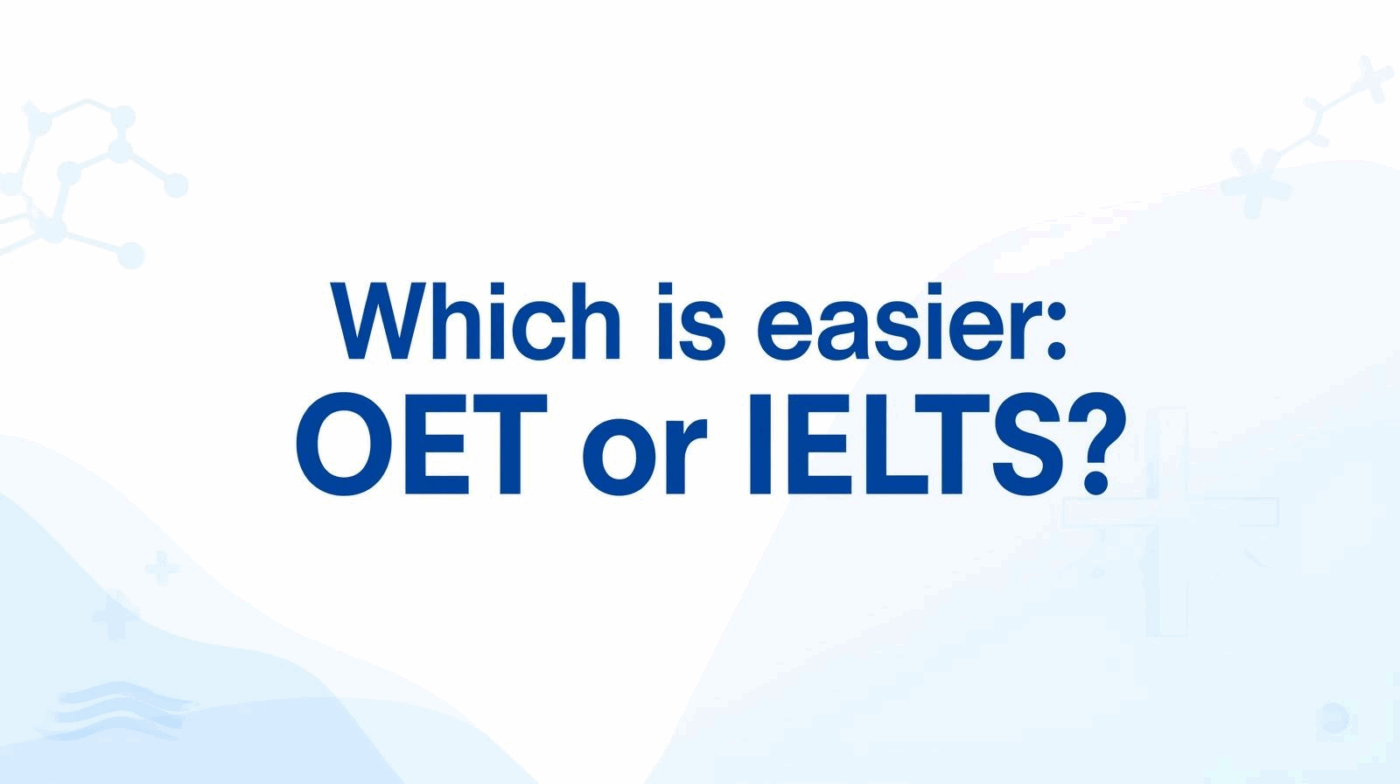OET Strategies
OET Grade B vs IELTS 7.0: Which Is Easier for International Medical Graduates?
OET and IELTS are two of the most common English tests required for healthcare professionals looking to work abroad or convert their medical licenses obtained overseas.
When given the choice, many IMGs wonder: “Which is easier—OET Grade B (350–440) or IELTS 7.0?”
The conclusion, in general, is that OET 350 is slightly easier to achieve than IELTS 7.0. The main reason is that speaking and writing, which are often the most difficult sections for IMGs, tend to be more manageable in OET.
In this article, we’ll take a closer look at how OET Grade B (350–440) compares with IELTS 7.0.
※This article is written by OET Bank, where we specialize in helping healthcare professionals prepare for OET and support their overseas career opportunities.
OET and IELTS Test Information
Overview of OET
The Occupational English Test (OET) is often referred to as a “medical English exam” or “English for healthcare professionals.” Here’s a summary:
- Name: Occupational English Test
- Content: Communication and medical-related topics in healthcare settings
- Test Time:
- Listening: 40 minutes
- Reading: 60 minutes
- Speaking: 20 minutes
- Writing: 45 minutes
- Scoring: Each section is scored out of 500
- Passing Score: 350+ in each section (Grade B or higher)
- Fee: 587 AUD
- Official Website: occupationalenglishtest.org
- Frequency: About 14 test dates per month
OET focuses on real-world medical communication. It evaluates whether non-native English speakers have the language ability to work in healthcare abroad.
It is also required when converting medical licenses obtained overseas into valid licenses in countries such as Australia, New Zealand, or the UK.
Professions Covered by OET
OET is available only for certain professions, including:
- Medicine (Doctors)
- Nursing
- Dentistry
- Dietetics
- Pharmacy
- Optometry
- Occupational Therapy
- Veterinary Science
- Podiatry
- Physiotherapy
- Speech Pathology
- Radiography
Countries Accepting OET
OET can be used for healthcare registration in:
- Australia
- Dubai
- Ireland
- Namibia
- New Zealand
- United Kingdom
- Ukraine
- United States (in some states)
- Canada (in some provinces under certain conditions)
Most IMGs preparing with us aim for the US, Australia, or the UK.
Overview of IELTS
IELTS (International English Language Testing System) is widely used for immigration, university admissions, and professional registration abroad.
- Name: The International English Language Testing System
- Content: Measures overall English proficiency
- Test Time:
- Listening: 40 minutes
- Reading: 60 minutes
- Speaking: 12–14 minutes
- Writing: 60 minutes
- Scoring: 0–9.0 in 0.5 increments
- Fee: 200〜350 USD
- Official Website: https://ielts.org/
- Frequency: Nearly daily, depending on the venue
IELTS has two modules: Academic (for study abroad) and General (for immigration). For healthcare licensing abroad, Academic IELTS is usually required, with a minimum of 7.0 in each band.
Unlike OET, IELTS assesses general English ability in all contexts—not just medical scenarios.
Score Conversion
Let’s look at the score conversion between the two exams:
- OET is scored on a 0–500 scale (Grades A–E).
- IELTS is scored on a 0–9.0 scale with half-band increments.
OET Grade B (350–440) corresponds to IELTS 7.0–7.5.
For most licensing boards, either OET B or IELTS 7.0 is the requirement.
Difficulty Comparison
As noted earlier, overall OET 350 is slightly easier to achieve than IELTS 7.0—with one exception. If listening is a major weakness, IELTS may feel easier, as OET listening is more demanding.
Here’s a closer breakdown:
Reading
IELTS Reading is harder.
- Higher word count under strict time limits
- More question types (14 in total)
- More complex passages
In IELTS, candidates must read about three passages (900 words each) and answer 40 questions in 60 minutes.
By contrast, IMGs who can score IELTS Reading 6.5 usually manage OET Reading 350+ without much extra preparation.
Listening
OET Listening is significantly harder.
- Frequent spelling mistakes due to medical terms
- Strong Australian accents (80% of recordings)
- Rapid speech and connected sounds
- Answer choices require interpretation
Because OET is built around clinical communication, audio is less “clear” than IELTS, which uses more neutral accents.
Writing
IELTS Writing is much harder.
- Almost no tolerance for grammar or vocabulary mistakes
- Two tasks in 60 minutes (vs. one task in OET)
- Requires strict logical development
Many native speakers without preparation score 6.5 in IELTS Writing, even with perfect scores elsewhere.
By contrast, OET Writing allows more tolerance for language mistakes and is easier for IMGs since the task involves familiar clinical letters.
Speaking
IELTS Speaking is slightly harder.
- Higher fluency demands
- Stricter assessment of pronunciation
- Abstract or unexpected questions
OET Speaking is role-play based and allows candidates to use their professional knowledge. Since healthcare workers discuss familiar scenarios, it feels easier than IELTS.
Fastest Route to OET 350
- First achieve IELTS Overall 6.0–6.5
- Switch to OET and target Grade B
Why? Because OET assumes solid general English ability. Without this foundation, you’ll struggle with medical content. That’s why many OET preparation programs abroad require IELTS 6.0–6.5 for entry.
Why Switch from IELTS to OET?
Most candidates struggle with IELTS Speaking and Writing. Achieving 7.0 in both can take years.
OET, however, tests communication in your own professional field, making it far more approachable once you have general English ability at IELTS 6.0–6.5.
Summary
- OET 350 is generally easier to achieve than IELTS 7.0
- OET Listening is more challenging
- IELTS Writing and Speaking are tougher
The bottom line: OET 350 is more achievable for most IMGs than IELTS 7.0.
Still, individual strengths and weaknesses vary. The best way is to try a mock test for both and see which path fits you best.
If you’re preparing for OET, consider exploring our practice resources at OET Bank. We’re designed not just as mock tests, but as powerful review tools that make it easier to analyze weaknesses and focus on what’s needed to pass.


